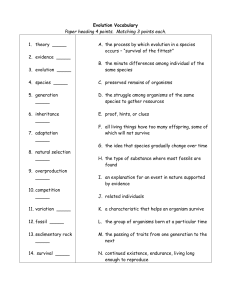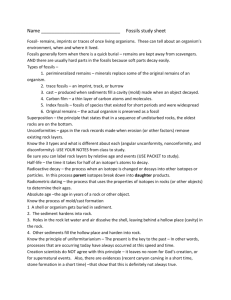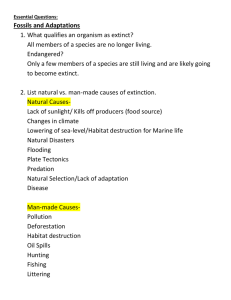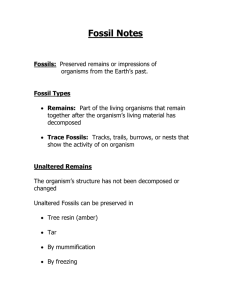Fossils and Age or Rocks
advertisement
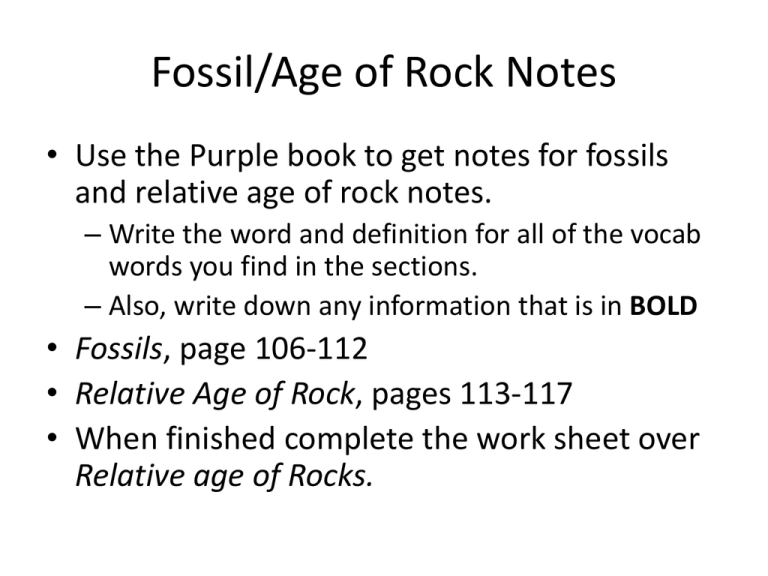
Fossil/Age of Rock Notes • Use the Purple book to get notes for fossils and relative age of rock notes. – Write the word and definition for all of the vocab words you find in the sections. – Also, write down any information that is in BOLD • Fossils, page 106-112 • Relative Age of Rock, pages 113-117 • When finished complete the work sheet over Relative age of Rocks. Types of Fossils Hint: if it’s purple it goes in your notes Paleontologists • paleontologists - Scientists who study fossils The Fossil Record • The record of fossils on earth that help give evidence about the history of life on earth. • Shows how groups of organisms may have changed over time • This is much of what the Theory of Evolution is based on – Gradual change in living things over long periods of time Fossils are NOT bone • When a fossil is found in rock – it is not the actual organism – the organism has been replaced with minerals Types of Fossils Made of Minerals • Petrified fossils • Mold • Cast • Carbon film • Trace fossils Organism • Preserved remains •99% of all organisms that die do NOT become fossils •99% of all organisms that have lived on earth have become extinct •Fossils give us a historical picture of what the Earth was like in the past but because fossils are very rare, there might be gaps in the historical record. Molds and Casts • Mold is the hollow area the organism once took up • Usually concave – Ex: ice cube tray Molds and Casts • Cast is the copy of the shape of an organism that would be made in a mold. • Usually convex – Ex: ice cubes Molds and Cast • Question: Which is the mold and which is the cast? • Answer: the mold is the tray, the casts are the ice cubes Preserved Remains - Jackpot! • Organisms can become preserved whole when they are caught in tar, amber (tree sap), mud pits, or ice that harden around them – Usually small organisms or plants… Petrified Fossils • Mineral replacement – Pg 107, Fig 2 – draw/label in notes – As organism decomposes and erodes away minerals flow in to replace pieces of organism – Ex: Petrified wood Carbon Film • Thin “film” coating of carbon is left on the rock when the organism gets squished – only carbon film is left behind Trace Fossils • Evidence (or traces) of an organisms activity or life – Ex: footprints, burrows, termites eating… Index Fossils • Fossils of the same short lived species that are widely distributed over the earth – Help geologists match rock layers that have moved – Show relative age of rock they are found in Finding the Relative Age of Rocks Questions • • • • • What are the relative and absolute ages? What is the law of superposition? What are unconformities? What are faults intrusions and extrusions? How are fossils used to date rocks? • The relative age of a rock is its age compared to the ages of other rocks. – It is like comparing your age to someone else’s • The relative age does not provide its absolute age • The absolute age of a rock is the number of years since the rock formed. – It is difficult for geologists to determine the absolute age • The law of superposition states that in horizontal layers of sedimentary rock, each layer is older than the layer above it and younger than the one below it. • Unconformity is where an old eroded surface is in contact with a new rock layer. • Faults can occur only after rock layer have formed; therefore rock layers are older than the faults • Igneous rocks that have formed as magma and cool underground are called intrusions • Extrusion are volcanic, molten materials that cool and harden when they reach the Earth’s surface Types of Fossils Hint: if it’s purple it goes in your notes Paleontologists • paleontologists - Scientists who study ___________ The Fossil Record • The __________ of fossils on earth that help give evidence about the history of life on earth. • Shows how groups of organisms may have ________________________________ • This is much of what the Theory of Evolution is based on – Gradual change in living things over long periods of time – See pg. 111 Fossils are NOT bone • When a fossil is found in rock – it is not the actual organism – the organism has been replaced with _____________ Types of Fossils Made of Minerals • _____________ • _____________ • _____________ • _____________ • _____________ Organism • _____________ •99% of all organisms that die do NOT become fossils •99% of all organisms that have lived on earth have become extinct •Fossils give us a historical picture of what the Earth was like in the past but because fossils are very rare, there might be gaps in the historical record. Molds and Casts • _____________ is the hollow area the organism once took up • Usually _____________ – Ex: ice cube tray Molds and Casts • _____________is the copy of the shape of an organism that would be made in a mold. • Usually _____________ – Ex: ice cubes Molds and Cast • Question: Which is the mold and which is the cast? • Answer: the mold is the tray, the casts are the ice cubes _____________- Jackpot! • Organisms can become preserved whole when they are caught in tar, amber (tree sap), mud pits, or ice that harden around them – Usually small organisms or plants… _____________ • Mineral replacement – Pg 107, Fig 2 – draw/label in notes – As organism decomposes and erodes away minerals flow in to replace pieces of organism – Ex: Petrified wood _____________ • Thin “film” coating of carbon is left on the rock when the organism gets squished – only carbon film is left behind _____________ • Evidence (or traces) of an organisms activity or life – Ex: footprints, burrows, termites eating… _____________ • Fossils of the same short lived species that are widely distributed over the earth – Help geologists match rock layers that have moved – Show relative age of rock they are found in Finding the Relative Age of Rocks Questions • • • • • What are the relative and absolute ages? What is the law of superposition? What are unconformities? What are faults intrusions and extrusions? How are fossils used to date rocks? • The _____________ of a rock is its age compared to the ages of other rocks. – It is like comparing your age to someone else’s • The relative age does not provide its absolute age • The _____________of a rock is the number of years since the rock formed. – It is difficult for geologists to determine the absolute age • The _______________________states that in horizontal layers of sedimentary rock, each layer is older than the layer above it and younger than the one below it. • _____________ is where an old eroded surface is in contact with a new rock layer. • Faults can occur only after rock layer have formed; therefore rock layers are older than the faults • Igneous rocks that have formed as magma and cool underground are called _____________ • _____________ are volcanic, molten materials that cool and harden when they reach the Earth’s surface
